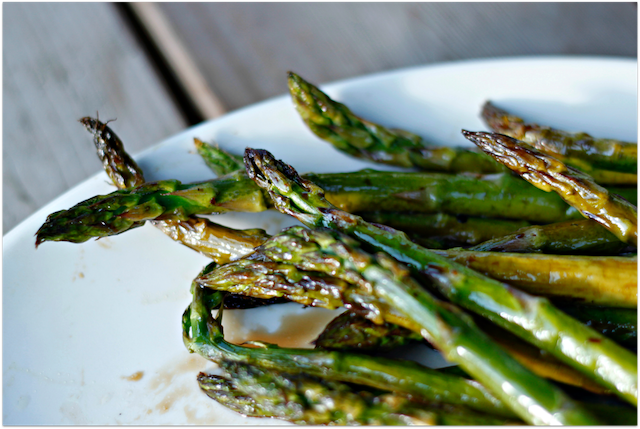
Spring has sprung, and asparagus spears are sprouting.
A perennial favorite that epitomizes seasonality, this vegetable is beloved by chefs and amateur eaters alike. Here are 26 hows and whys to enjoy this lovely springtime gem:
A: Antioxidants
Loaded with vitamins A, C, and E, as well as other powerful antioxidants, asparagus acts as a veggie superhero, fighting to neutralize cell-damaging, villainous free-radicals in our body. A diet that includes between five and eight servings of antioxidant-rich fruits and vegetables (like asparagus) helps to keep the bad guys from wreaking havoc and causing nasty diseases like cancer.
B: Beauty
The slender stalks of this herbaceous perennial plant are something to behold. And eating asparagus enhances our beauty—its Vitamin C and E nourish the skin and boost collagen production.
C: Colorful
Think asparagus only comes in shades of green? Not true! Asparagus shows herself in the familiar spring green as well as hues of white and purple. Chlorophyll makes green asparagus green; white asparagus is simply green asparagus grown in the absence of light, thus no chlorophyll; and purple asparagus gets her lovely hue due to the presence of anthocyanins, which are potent antioxidants that may help prevent cancer and cardio-vascular disease.
D: Dipper
Trim spears by snapping off the tough ends, steam in a steamer basket set over boiling water until tender but still firm (this will take about three to four minutes) and use for dipping. Asparagus is especially delicious dipped into a soft-boiled egg with its top cut off, or as a naturally gluten-free dipper for hummus and guacamole.
E: Eggs
Fresh asparagus and fluffy eggs make an exquisite omelet: Sauté a few chopped spears in some olive oil (the tough stem ends can be peeled and used for this—see W for Woody Stem) and set aside. Beat three eggs and pour into a hot eight-inch skillet coated with olive oil. Shake and stir the eggs continuously until set on the bottom. Spread the cooked, chopped spears down the middle of the set eggs and fold the omelet in half. Turn out onto a warm plate and serve with a glass of bubbles! (See U for Unique.)
F: Folate
Asparagus is one of the best sources of naturally occurring folate, which helps prevent birth defects and also promotes production of healthy red blood cells.
G: Grilled
Grilled asparagus is easy and delicious. Trim spears (see T for Trimming), leave whole, drizzle with olive oil, season with salt and pepper and cook on a hot grill until tender.
H: Highfalutin
Feelin’ fancy? Pour a glass of sparkling wine (see U for Unique), steam some spears and wrap ‘em with smoked salmon. Serve with a honey Dijon dipping sauce. Ooh la la!
I: Ice
What does ice have to do with asparagus? Well, steam the asparagus, then immediately dunk it into a bath of ice water to halt the cooking. This extra step provides perfectly crisp tender stalks that retain their vibrant green color.
J: Jonquils
Asparagus and jonquils are both eagerly awaited signs of spring and both sorely missed once the weather heats up. But that’s the bittersweet beauty of eating seasonally. Not only does locally grown, seasonal food taste better, asparagus grown by a local farmer uses fewer precious natural resources to get to our table. Unless we live in Peru, we’re likely not meant to eat asparagus in winter.
K: Vitamin K
One cup of cooked asparagus delivers 101% of the daily recommended value of Vitamin K. Vitamin K plays a starring role in blood clotting, and is also helps builds strong bones and assists in preventing heart disease.
L: Libido
Not only is asparagus suggestive to look at, its high folate levels aid in the production of histamine which is important for a healthy sex drive in both men and women. Cooked whole spears, picked up and dipped in Parmesan lemon butter with fingers—finger-licking sexy.
M: Mediterranean
Asparagus was first cultivated in the Eastern Mediterranean region more than 2,000 years ago! Those ancient Greeks and Romans had good taste. No wonder asparagus goes so well with the sunny flavors of the Mediterranean such as lemons, oranges, pine nuts, and olives.
N: Nation
China is by far the nation that produces the most asparagus. Reside in China? If not, think local and seasonal. Just imagine the carbon footprint.
O: Organic
While it’s always best to buy organic whenever possible, asparagus is on the Environmental Working Group’s most recent Clean Fifteen list, which is a list of produce grown using the least amount of pesticides. If there’s a local organic source of asparagus, bonus. If not, don’t worry and enjoy anyway.
P: Pee
Yes, eating asparagus might make our pee stink. That’s because it contains a chemical called asparagusic acid, which is broken down by our bodies into sulphuric compounds during digestion. Sulphur is smelly, so that’s why our pee might smell after eating asparagus.
Q: Quick
Be quick about it. Asparagus is best eaten fresh. Another reason to eat local and seasonal.
R: Roast
One of the easiest and tastiest ways to cook asparagus is to roast it. Preheat oven to 425° and trim one bunch of asparagus as described in T for Trimming. Place whole, trimmed spears in a single layer on a baking sheet. Drizzle with one tablespoon olive oil, one tablespoon balsamic vinegar and sprinkle with salt and a few crushed red chili flakes. Roast 10-15 minutes, depending on thickness, until just tender.
S: Storage
Asparagus has a high respiration rate, which makes it susceptible to drying out, shriveling and wrinkling. (Sound familiar?) To help slow this unpleasant aging process, store asparagus with the ends wrapped in a damp paper towel, or standing up in an inch or two of water like flowers in a vase
T: Trimming the ends
The easiest way to trim the tough ends at the appropriate place is to pick up each spear individual, and give it a snap. The spear will break at the magic place with the tender edible part in one hand and the woody end in the other (see W for Woody stem.)
U: Unique
Asparagus is fun and funky. It grows out straight up out of the ground and has a unique flavor—fresh and grassy. This vegetal taste that makes asparagus such a seasonal treat can make pairing it with wine quite tricky. What’s a connoisseur to do? As with all difficult-to-pair-with-wine foods, pour a glass of bubbles!
V: Velvety
Asparagus can be turned into a rich and velvety soup. In a large pot, sauté two chopped shallots and one minced clove of garlic in a tablespoon of olive oil. Toss in one bunch of asparagus, trimmed and chopped (see T for Trimming). Add four cups of veggie broth and cook until asparagus is tender. Cool slightly and puree, then stir in a cup of milk (non-dairy or otherwise) and a handful of chopped fresh herbs—dill is nice. Season with salt and pepper and a squeeze of fresh lemon juice.
W: Woody stem
When trimming the tough ends of the stems (see T for trimming the ends) don’t toss them in the compost. Peel them with a vegetable peeler and use to make soup (S for Soup) or slice, sauté and toss into an omelet (E for Eggs.)
X: Xeriscaping
A loose definition of xeriscaping is gardening or landscaping that reduces or eliminates the need for water by artificial irrigation. If we live in an area that gets a fair amount of rain, it’s possible to xeriscape with asparagus. The plant is a perennial, will grow wild and can get by without extensive watering.
Y: Yes
Just say yes when offered a second helping of asparagus. One cup of cooked asparagus has around 40 calories. Maybe hold the second helping of hollandaise.
Z: Ziti
Asparagus goes great with ziti, or any pasta for that matter. Cook one pound of ziti until al dente. Saving a bit of the cooking liquid, drain cooked pasta and toss with one bunch of asparagus cooked and chopped, four tablespoons extra virgin olive oil, the juice of one lemon and a bit of the pasta cooking water if needed. Divide into individual pasta bowls and sprinkle each serving with freshly grated Parmesan cheese, a bit of chopped parsley and a few toasted pine nuts.
Author: Lisa Murphy
Editor: Emily Bartran
Photo: Author’s Own










Read 0 comments and reply